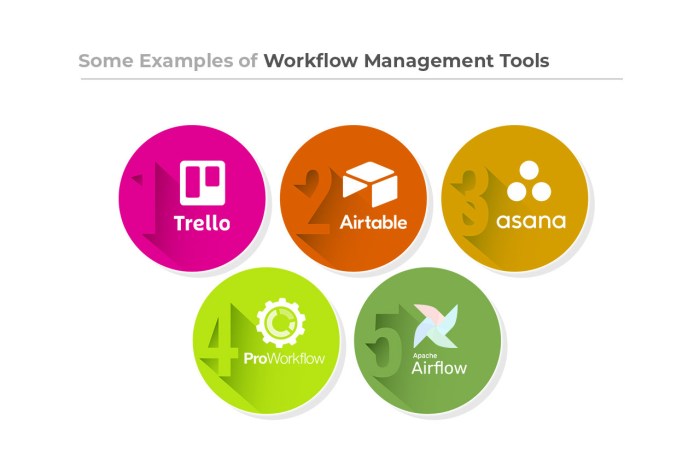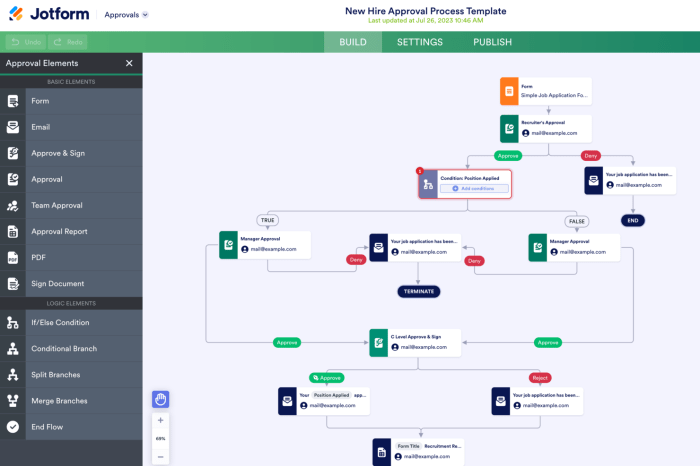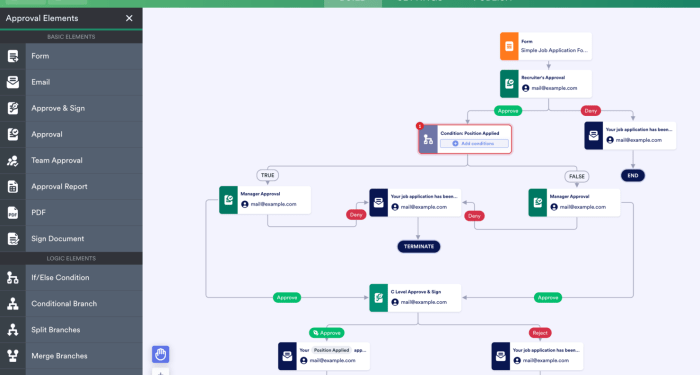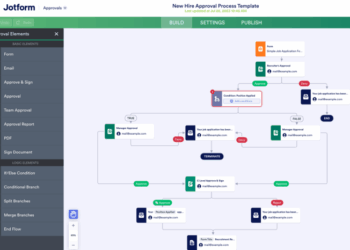Embark on a journey through the world of Workflow Management Tools that seamlessly grow with your business. Discover how these tools revolutionize business processes and adapt to your evolving needs.
As we delve deeper into the realm of scalable workflow management tools, you'll uncover essential insights and practical tips to enhance your business operations.
Definition of Workflow Management Tools
Workflow management tools are software applications designed to help organizations automate, manage, and optimize their business processes. These tools enable businesses to streamline their workflows, improve efficiency, and ensure tasks are completed in a timely manner.
How Workflow Management Tools Help Streamline Business Processes
- Automation: Workflow management tools automate repetitive tasks, reducing manual errors and saving time.
- Centralized Communication: These tools provide a centralized platform for team collaboration, communication, and task assignment.
- Tracking and Monitoring: Workflow management tools allow businesses to track the progress of tasks, identify bottlenecks, and monitor performance metrics.
Examples of Popular Workflow Management Tools in the Market
- Trello: A popular project management tool that uses boards, lists, and cards to organize tasks and workflows.
- Asana: An intuitive task management tool that helps teams track work, set priorities, and collaborate effectively.
- Monday.com: A versatile platform that enables teams to plan, track, and manage projects in a visual and customizable way.
Importance of Scalability in Workflow Management Tools
Scalability plays a crucial role in the efficiency and growth of businesses when it comes to workflow management tools. Let's delve into why scalability is essential for business success.
Adaptability to Changing Business Needs
Scalable workflow management tools are designed to adjust and expand according to the evolving requirements of a business. This adaptability ensures that the tools can grow alongside the organization and accommodate increased workflow complexities without causing disruptions.
- Efficiency Boost: Scalable tools enable businesses to streamline their processes, automate repetitive tasks, and optimize workflows as operations expand.
- Cost-Effectiveness: By investing in scalable tools, businesses can avoid the need for frequent software changes or upgrades, saving both time and resources in the long run.
- Flexibility: Scalable workflow management tools provide the flexibility to customize workflows, add new features, and integrate with other systems seamlessly.
Examples of Businesses Benefiting from Scalable Tools
Several organizations have experienced significant improvements in their operations and growth by adopting scalable workflow management tools. Here are a few examples:
Company A, a digital marketing agency, saw a 30% increase in productivity after implementing a scalable workflow management tool that could accommodate their expanding client base and diverse projects.
Company B, a manufacturing firm, reduced operational costs by 20% by using scalable tools to automate inventory management, production scheduling, and quality control processes.
Company C, an e-commerce retailer, improved customer satisfaction and order fulfillment rates by 25% by integrating scalable workflow management tools that optimized warehouse operations and order processing.
Features to Look for in Scalable Workflow Management Tools
When choosing a workflow management tool for your business, it is crucial to consider scalability. Scalability ensures that the tool can grow and adapt along with your business, accommodating increasing demands and complexities. Here are some key features to look for in scalable workflow management tools:
Automation
Automation is a critical feature in scalable workflow management tools. The ability to automate repetitive tasks and streamline processes not only increases efficiency but also allows for easier scalability. Look for tools that offer robust automation capabilities, such as task triggers, auto-assignments, and workflow templates.
Automation reduces manual intervention, minimizes errors, and enables seamless scaling as your business expands.
Customization
Another important feature to consider is customization. Scalable workflow management tools should allow for flexibility and customization to meet the unique needs of your business. Look for tools that offer customizable workflows, user roles, and permissions. The ability to tailor the tool to your specific requirements ensures that it can grow alongside your business without constraints.
Integration
Integration capabilities are also crucial for scalability. A scalable workflow management tool should seamlessly integrate with other essential business tools and systems, such as CRM software, project management platforms, and communication tools. Integration enables data sharing, improves collaboration, and ensures a cohesive workflow across different departments and teams.
Scalability Planning
Lastly, consider whether the workflow management tool has scalability planning features. Tools that provide insights into performance metrics, capacity planning, and resource allocation help you anticipate and prepare for future growth. Scalability planning features enable you to proactively address potential bottlenecks and ensure smooth scalability as your business evolves.In conclusion, when evaluating workflow management tools for scalability, prioritize automation, customization, integration, and scalability planning features.
These key elements will not only support your current workflow needs but also future-proof your business for growth and expansion
Case Studies

In this section, we will explore real-life examples of companies that have successfully scaled using workflow management tools. These case studies will provide insights into how these tools have contributed to their growth and the challenges they may have faced during the scaling process.
Company A
- Company A, a tech startup, implemented a scalable workflow management tool to streamline their project processes.
- The tool helped them automate repetitive tasks, allocate resources efficiently, and track project progress in real-time.
- As a result, Company A saw a significant increase in productivity, reduced project delivery times, and improved overall project quality.
- However, they faced challenges in adjusting to the new tool, training employees, and integrating it with existing systems.
Company B
- Company B, a marketing agency, adopted a scalable workflow management tool to manage client projects more effectively.
- The tool enabled them to create customized workflows for each client, improve communication among team members, and track project milestones efficiently.
- With the help of the tool, Company B was able to handle a larger volume of projects, deliver results faster, and maintain high client satisfaction.
- However, they encountered challenges in aligning the tool with client requirements, ensuring data security, and providing adequate training to their staff.
Tips for Implementing Scalable Workflow Management Tools
Implementing scalable workflow management tools in a business requires careful planning and execution to ensure a smooth transition. Here are some best practices to consider:
Evaluate Your Current Workflows
Before implementing any new tool, it is essential to evaluate your existing workflows to identify areas that can be improved. Look for bottlenecks, inefficiencies, and areas where automation can streamline processes.
Set Clear Goals and Objectives
Clearly define what you aim to achieve with the implementation of scalable workflow management tools. Whether it is to increase productivity, reduce errors, or improve collaboration, having specific goals will guide the implementation process.
Involve Stakeholders from the Beginning
Engage key stakeholders, including employees who will be using the tools, managers, and IT personnel, from the early stages of implementation. Their input and feedback are crucial for successful adoption.
Provide Adequate Training and Support
Ensure that employees receive proper training on how to use the new tools effectively. Offer ongoing support to address any issues or questions that may arise during the transition period.
Pilot Test Before Full Implementation
Consider piloting the scalable workflow management tools in a smaller team or department before rolling them out company-wide. This allows you to identify any potential challenges and make adjustments as needed.
Monitor Progress and Adjust as Needed
Regularly monitor the progress of the implementation and gather feedback from users. Be prepared to make adjustments to the workflows or tools based on the feedback received to ensure optimal performance.By following these tips and best practices, you can effectively integrate scalable workflow management tools into your business and achieve improved efficiency and productivity.
Epilogue

In conclusion, Workflow Management Tools That Scale With Your Business offer a strategic advantage in today's dynamic market. By leveraging these tools effectively, businesses can optimize efficiency and drive sustainable growth.
Questions Often Asked
How do workflow management tools contribute to business efficiency?
Workflow management tools streamline processes, automate tasks, and enhance collaboration, resulting in improved productivity and reduced errors.
Can scalable tools accommodate the changing needs of a growing business?
Absolutely, scalable tools can expand functionality and capacity to meet increased demands as a business evolves and expands.
What are some key features to look for in scalable workflow management tools?
Key features include customizable workflows, integration capabilities with other tools, robust reporting functionality, and scalability in terms of user numbers and data handling.












